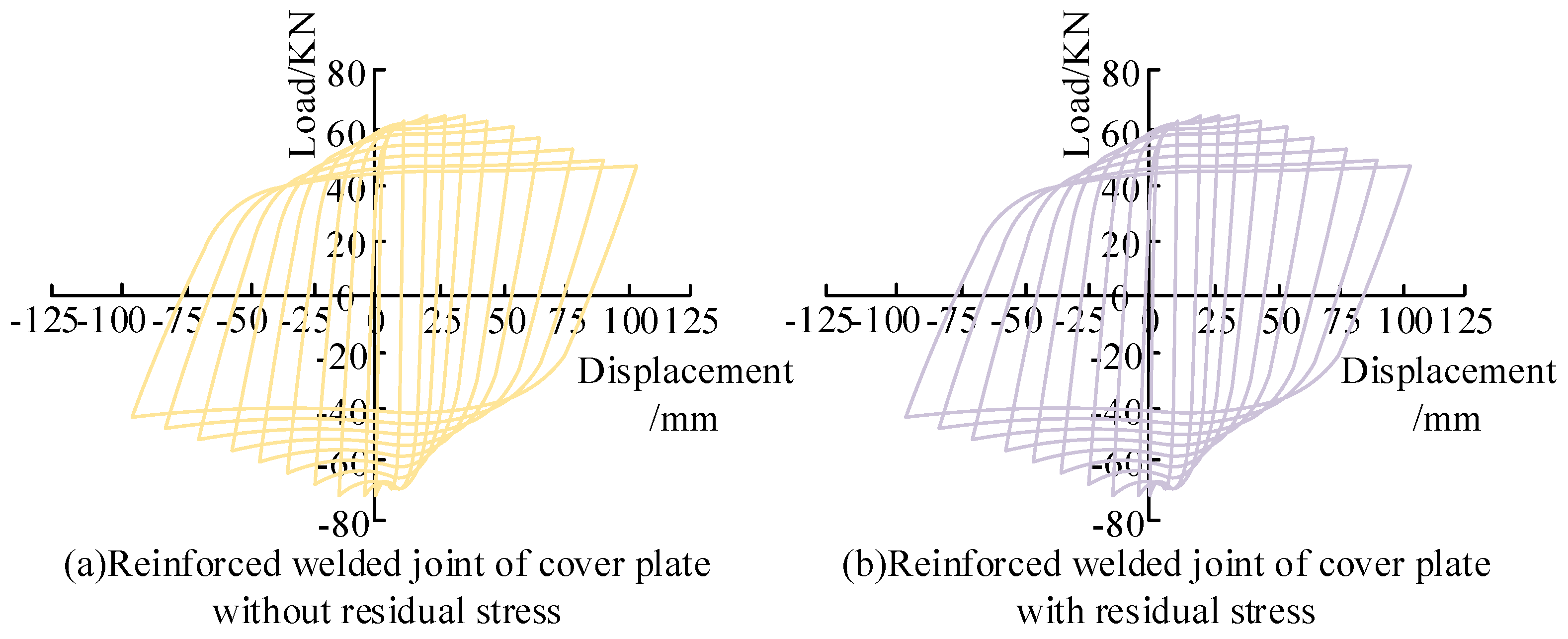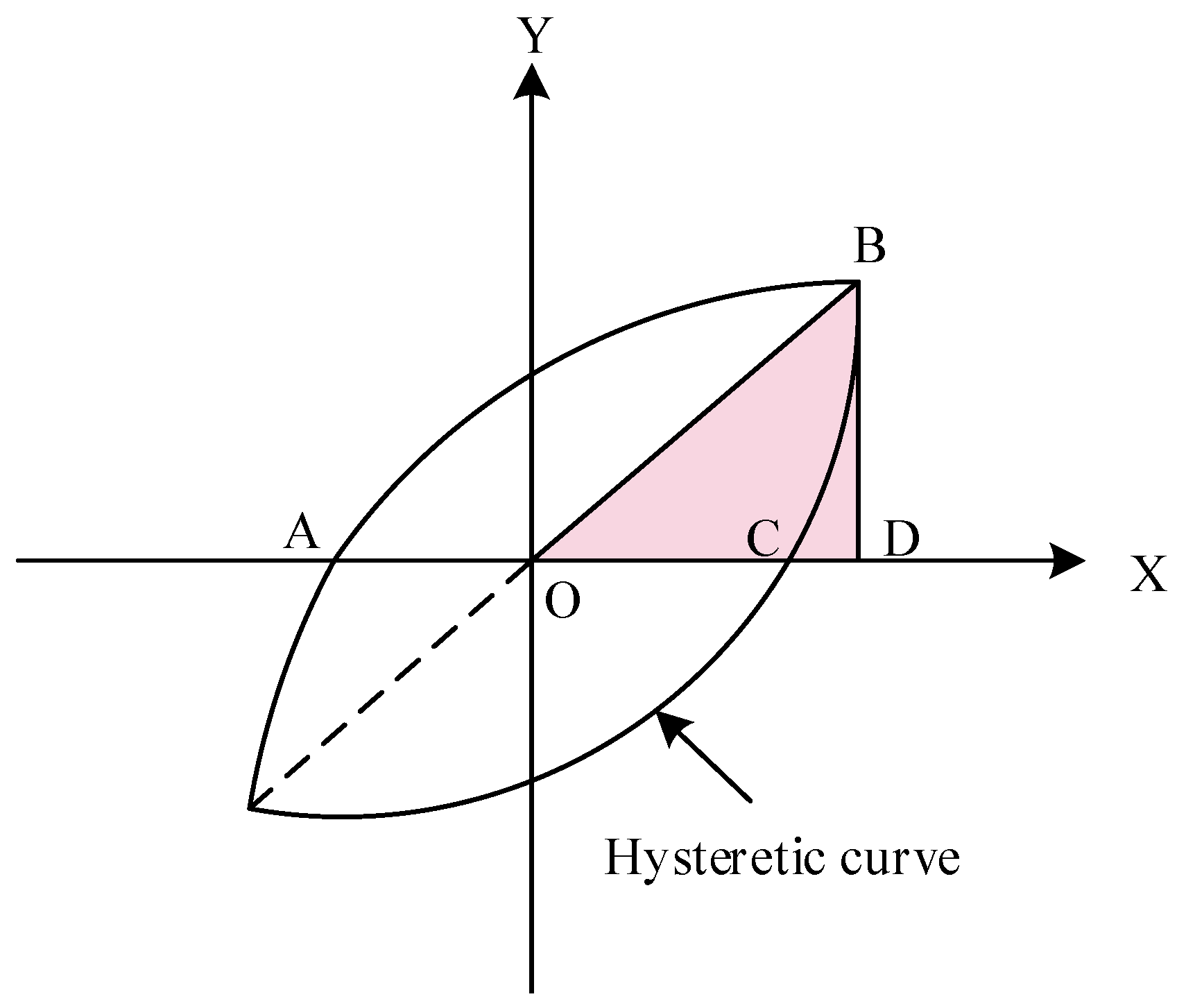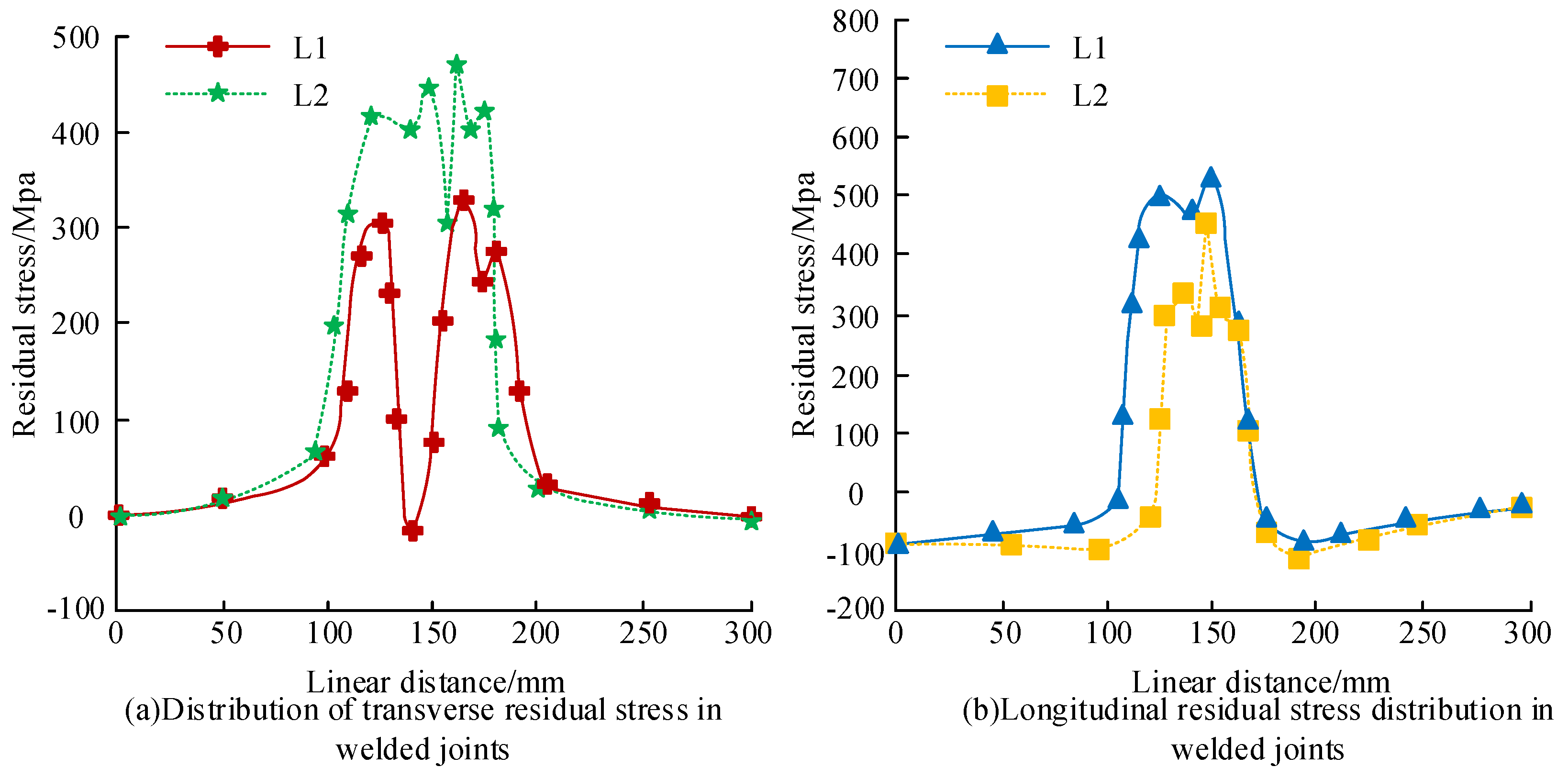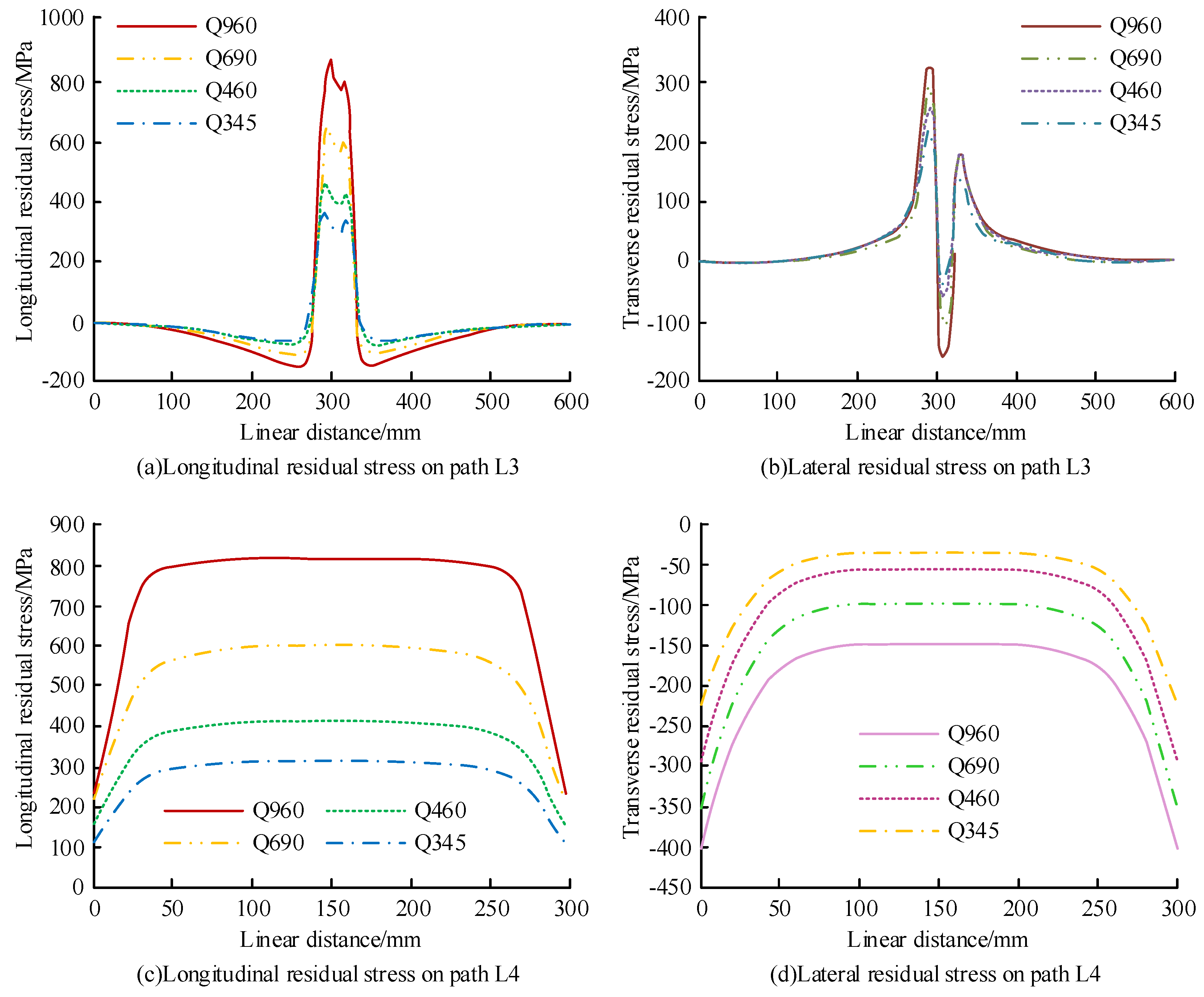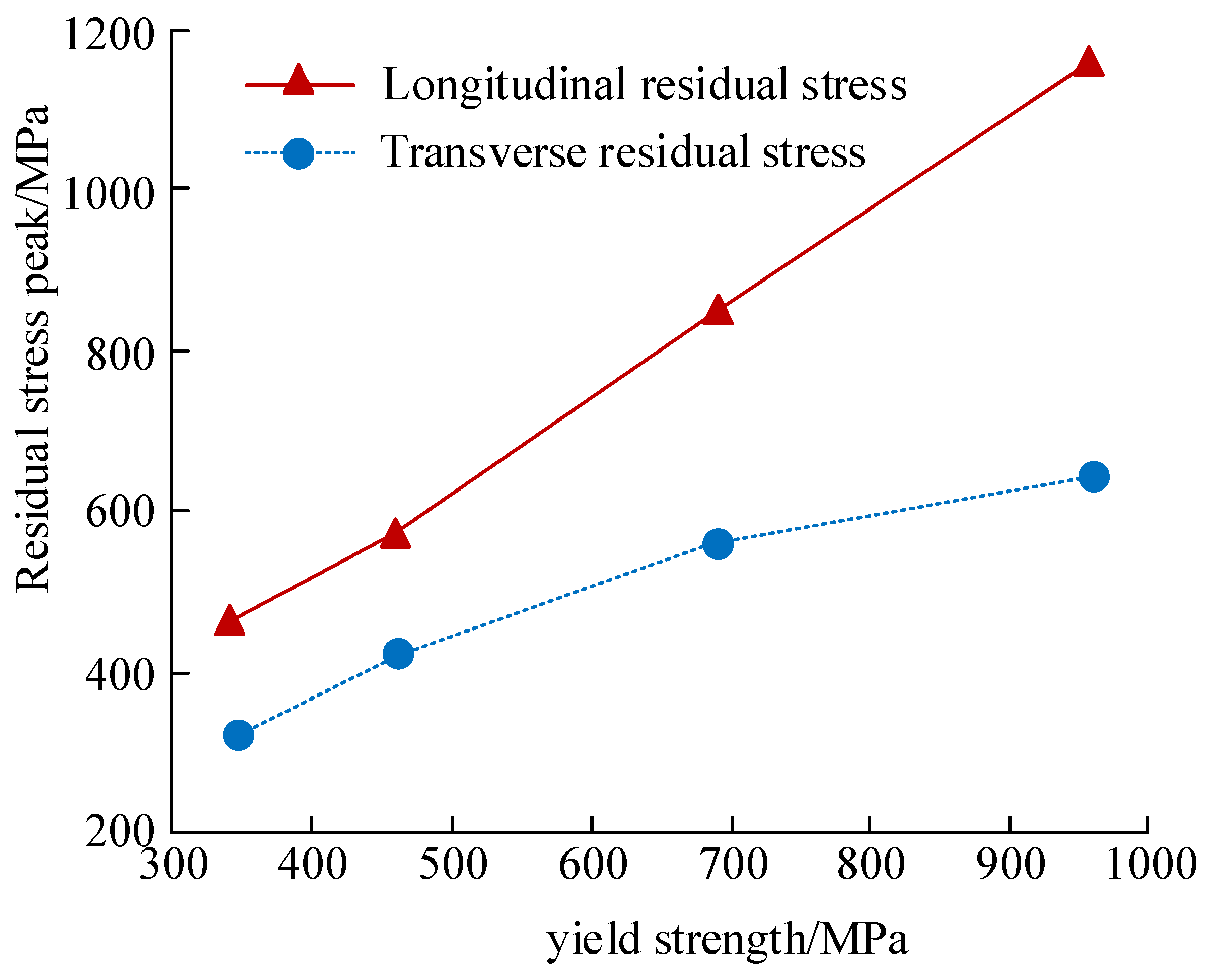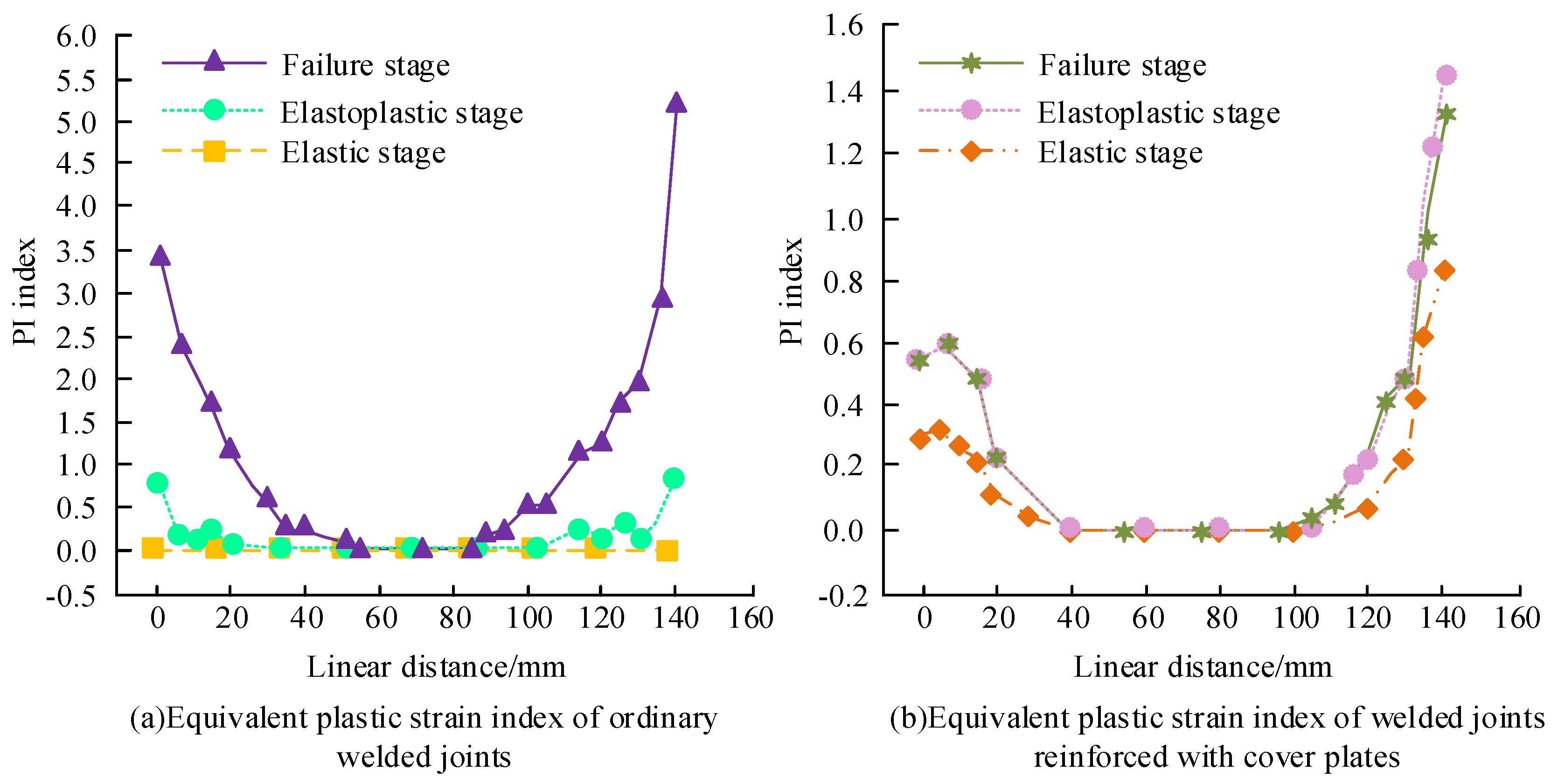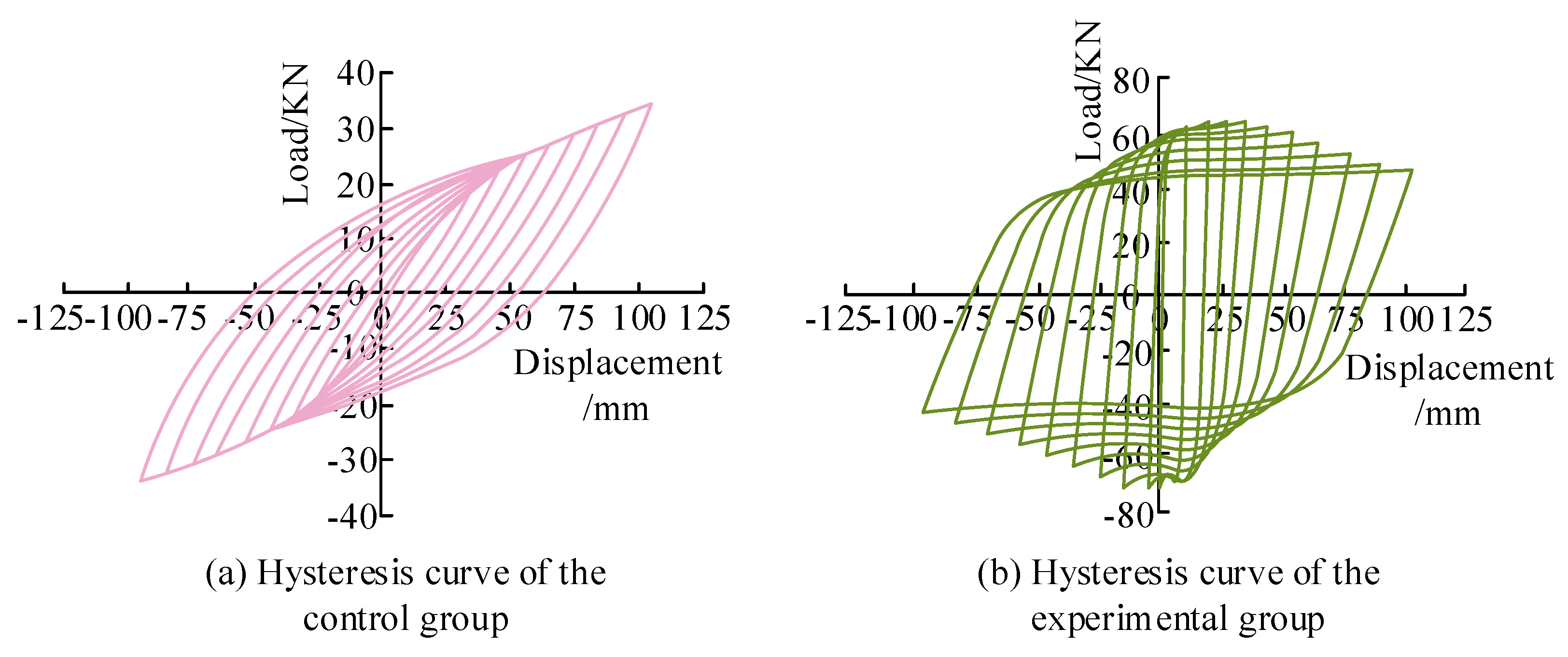1. Introduction
In recent years, the proportion of steel structures used in the field of engineering construction has been increasing year by year due to advantages such as high strength, fast construction, light weight, high production efficiency, reusability, and excellent seismic and mechanical properties [
1,
2]. As a commonly used processing method and manufacturing process, welding technology is widely used in the production and construction of building steel structures (BSS) due to advantages such as high structural stiffness, good connection performance, and wide process adaptability [
3,
4]. However, during the welding of steel structures, uneven temperature fields are generated due to the heating and cooling of local components, resulting in residual stress (RS) and deformation of the components. The RS of welded joints is not only the main cause of cracks in BSS, but is also an important factor in causing brittle fracture and corrosive cracks. RS in welded joints refers to the stress generated in the joint area during the welding process by factors such as local heating and uneven cooling of the material [
5,
6].
These stresses will generate certain stress concentrations at the welded joints, thereby affecting the load-bearing capacity and seismic performance of the structure.
In earthquake action, the structure will be subjected to the inertial force of ground motion, which will cause changes in the RS at the welded joints. If there are significant RS in welded joints, these stresses may cause cracks, deformation, and other problems in the structure subject to seismic action, thereby affecting its stability and safety. In addition, earthquake action can also generate certain vibrations and impacts that impact the structure, which will further increase the RS at the welded joints, thereby exacerbating the degree of structural damage. In the design and manufacturing process, RS at the welded joint should therefore be minimized as much as possible, as this will improve the load-bearing capacity and seismic performance of the structure. This can be achieved by adopting reasonable welding processes, optimizing structural design, and selecting high-strength materials. At the same time, specialized seismic design and evaluation should be carried out based on seismic intensity for buildings or structures in earthquake prone areas, as this will ensure their safety and stability [
7].
There is a close relationship between performance indicators that reflect seismic performance. The existence of RS can affect the stiffness, energy dissipation capacity, ductility, and bearing capacity of the structure, thereby affecting its performance in earthquakes. Firstly, RS can cause changes in structural stiffness, and if there is RS in the welded joint, this stress will have an impact on the structural stiffness. In earthquake action, the stiffness of a structure determines its seismic response and stability. And if the RS at the welded joint is too large, it may therefore lead to a decrease in structural stiffness and an increase in the possibility of vibration.
Secondly, RS can also affect the energy dissipation capacity of the structure. During an earthquake, the structure needs to absorb and consume the energy generated by the earthquake to reduce the damage to it. If RS exists in welded joints, it may affect the yield point and tensile strength of structural materials, thereby affecting their energy dissipation capacity. If RS leads to a decrease in material strength, the energy dissipation capacity of the structure may decrease, thereby increasing its risk of failure in earthquakes. In addition, RS also affects the ductility and bearing capacity of the structure, and the RS in the welded joint area may cause plastic deformation of the material present, reducing its ductility. In earthquake action, structures need to have a certain degree of ductility and bearing capacity to cope with the impact and vibration generated by earthquakes. Therefore, if the RS at the welded joint is too large, it may reduce the ductility and bearing capacity of the structure, making it more prone to damage in earthquakes [
8].
In summary, the presence of RS can affect seismic performance indicators such as the stiffness, energy dissipation capacity, ductility, and bearing capacity of the structure. Therefore, in the design and manufacturing process, RS at the welded joints should be minimized as much as possible to improve the overall seismic performance of the structure. At the same time, specialized seismic design and evaluation should be carried out for buildings or structures in earthquake prone areas, taking into account the impact of RS and other factors, as this will ensure the safety and stability of the structure. At present, research of the initial stress of BSS often adopts qualitative analysis, and there are relatively few quantitative analysis studies of practical engineering. The finite element numerical simulation (FENS) technology can decompose complex physical problems into multiple simple parts for numerical calculation, and is widely used in practical engineering fields, such as structural mechanics, heat conduction and fluid mechanics [
9,
10].
In this context, we therefore conduct research of the numerical simulation of RS in the seismic performance of welded joints in BSS based on finite element (FE) methods, with the aim of improving the engineering application value of welded structures. The research mainly includes four parts. The second part is a review of the current research status of domestic and international RS and FENS technology. The third part studies the heat source model of welded joints in BSS based on the FE method: its first section explores the reasons for RS generation and the calculation method of stress-strain, and its second section simulates the heat source of welded joints in BSS based on the FE method. The third section studies the seismic performance of welded joints in BSS based on the FE method and the influence of RS. The fourth part is a FE numerical simulation of RS, which considers the seismic performance of welded joints in BSS.
2. Related Works
After welding, the material properties of metal components will be significantly weakened, and there will be RS in the component nodes. Many domestic and foreign experts and scholars have conducted relevant research of this, with the aim of exploring the impact of RS on the performance of welded joints. In seeking to observe the effect of RS on performance at the micro scale, S. Shah et al. [
11] proposed a new modeling framework for the calculation process, in which the curing state function was utilized to conduct material characterization work, build a new material database, and conduct modeling analysis of the curing process. The results showed that this method feasibly predicted accurate RS. Researchers such as M. Schori et al. [
12] have, in seeking to simulate and analyze real machining parts in a virtual environment, proposed using genetic algorithms to obtain optimized parameters for machining parts, and also suggested using FE analysis to numerically simulate the production of mechanical machining operations: their results showed that this method could simulate and analyze the deflection error and RS of processed parts. W. Guo’s et al. [
13], in seeking to improve the mechanical properties of the brazed joint, proposed to introduce metal foam as the intermediate layer in the microstructure of the brazed joint, and introduce Ag-based solid solution to the weld in order to make the weld center of the brazed joint smaller. They found that this method reduced the RS of the brazed joint by 22.18%, effectively improving the mechanical properties of the brazed joint. Scholars such as K. Saptaji et al. [
14] have, in seeking to control the fatigue life of work pieces during mechanical machining, proposed measuring the RS of mechanical and thermal loads generated during cutting machining, and also analyzed the relationship between RS and the depth of work pieces, finding that RS on the surface and subsurface of the work piece were more likely to cause plastic deformation. Researchers such as Y. Xiong et al. [
15] have, in seeking to improve the processing efficiency and accuracy of metal materials analyzed the relationship between surface roughness, fatigue life, and the RS of TiB2/7050Al, a new type of metal material, finding that the temperature generated during the cutting operation of this material had a significant impact on RS, and also identifying an exponential relationship between the surface roughness and fatigue life of this material.
Welding RS has a significant impact on the lifespan of steel structures, and it has attracted the attention of many experts and scholars. Scholars such as Zhang H et al. [
16] have, in seeking to improve the quality and safety of welding manufacturing, proposed a welding process simulation method that uses element birth and death technology to optimize the design of heat source parameters, finding that the equivalent RS near the weld reached a maximum value of 344 MPa, which was very close to the yield strength of
Q345 steel, demonstrating the feasibility of this method. Researchers such as Tabatabaean A et al. [
17] have, in seeking to gain a deeper understanding and control of welding RS, including its impact on the life of steel structures, r adopted the welding process simulation method of element birth and death technology, and also optimized the design of heat source parameters to reveal the formation and distribution patterns of RS in the welding manufacturing process. Meanwhile, the effects of different bending angles and welding paths on RS distribution were compared and analyzed, and the results showed that this method provided valuable reference for engineers and scientists working in the field of RS. Friedrich N et al. [
18] proposed to reveal the effect of welding RS on the initiation and propagation of fatigue cracks by comparing samples with different weld geometries, and conducting fatigue tests on multi-layer K-shaped butt welds and longitudinal stiffener samples. The results showed that, when there were the same number of cycles, samples in the welded state were more prone to the initiation of macroscopic cracks than those in the stress-relieved state. Abbasi M et al. [
19] proposed to improve the friction stir welding technology by comparing the effects of different processes on the microstructure and mechanical properties of AA6061-T6-aluminum-alloy-welded joints. Two variant technologies, friction stir vibration welding and underwater friction stir welding, were adopted, and the results showed that the improved process could effectively reduce the size and interparticle distance of precipitates. Chen J et al. [
20] aimed to investigate the effect of ultrasonic impact treatment (UIT) on RS in welded joints and explore its mechanism of action. A three-dimensional numerical analysis method was proposed, including thermomechanical-coupled-welding simulation and dynamic-elastoplastic-UIT simulation. This method was validated through X-ray diffraction measurement and theindentation strain method. Simulation results showed that the elastic strain slightly decreased after UIT, while the equivalent plastic strain significantly increased, indicating the mechanism of RS relaxation. Yang Y P et al. [
21], in seeking to reduce the impact of welding RS and deformation on the structural life and improve assembly accuracy and structural strength, suggested that, in the structural design stage, welding joint types and grooves should be reasonably selected, balanced welding technology should be adopted, plate thickness and stiffener spacing should be optimized, and distortion compensation should be considered. In the manufacturing phase, mitigation techniques included optimizing the welding sequence and reducing welding heat input; practice has proven both methods are feasible. Scholars such as Sarmat A et al. [
22] have, in seeking to explore the specific effects of multiple repair welding on the RS field of GMA welded S355J2+N and S960QL structural steel T-joints, proposed a method combining cyclic loading technology and machining technology, with the aim of simulating the generation and repair process of cracks. This experimental design accurately measured the RS state under different conditions by using an X-ray diffraction method. The research results showed that, regardless of the type of repair welding, this would inevitably increase the amount of RS in the structure. This discovery has an important guiding significance for understanding and optimizing welding processes, and especially T-joints with significant structural significance. Asadi P et al. [
23], in seeking to explore the formation of RS in stainless steel SUS304 pipes during multi-pass TIG welding, developed a non-coupled thermo-mechanical 3D FE model by using ABAQUS6.14 software. This model mainly simulated the heat distribution and stress status of circular welds around pipelines, and then analyzed the specific effects of weld bead quantity, electrode movement speed, and heat input on the surface tension, both inside and outside the pipeline. The simulation results revealed that increasing the welding speed could effectively reduce the axial tensile stress on the pipeline surface. This discovery provided useful guidance to the optimization of welding processes and efforts to ensure the stability of pipeline structures.
In summary, although many (domestic and foreign) experts and scholars have conducted many studies of the impact of RS, they have relatively rarely used FE methods to simulate and analyze the impact of RS on the seismic performance of welded joints in BSS in practical engineering. Therefore, we propose to research the numerical simulation of RS in the seismic performance of welded joints in BSS based on FE methods, with the aim of providing theoretical guidance to the targeted control of RS in the later stage.
4. Numerical Simulations of Seismic Performance and the RS of Welded Joints in BSS Based on FE Method
To verify the seismic performance of welded joints in BSS under RS conditions, numerical simulations were conducted on the seismic performance and RS of welded joints in BSS based on FE methods. We used the Sentinel-1A radar satellite dataset from NASA, which can reconstruct the coseismic deformation field of earthquakes. On this basis, the impact of stress on seismic performance could be analyzed by referring to changes in stress [
41]. Firstly, the RS in the transverse and longitudinal directions of the V-groove welded joint structure were verified, as shown in
Figure 9. In
Figure 9a, the abscissa represents the length distance between L1 and L2, while the ordinate represents the transverse RS. The distribution trend of transverse RS in L1 and L2 was found to be consistent, and both L1 and L2 achieved peak transverse RS at a length distance of 160 mm. The peak transverse RS in L1 and L2 was 475 MPa and 325 MPa, respectively, and in L2 reduced by 31.58%, when compared to L1.
In
Figure 9b, the horizontal axis represents the length distance between L1 and L2, while the vertical axis represents the longitudinal RS. The distribution trend and magnitude of the longitudinal RS in L1 and L2 had good consistency. At a length distance of 150 mm, the longitudinal RS peaks obtained in L1 and L2 were 525 MPa and 425 MPa, respectively. The longitudinal RS peak in L2 decreased by 19.05%, compared to L1. Overall, the RS in the vicinity of the weld seam was tensile stress, and the distribution trend of RS in the long and wide directions of the FE model was consistent. The above results confirm the transverse and longitudinal RS distribution of the V-shaped-groove-welded joint structure exhibited a certain regularity. In the lateral direction, the RS distribution trends of L1 and L2 were consistent, both peaking at a length distance of 160 mm. However, the peak RS in L2 decreased by 31.58%, compared to L1, indicating that, in the case of the transverse direction, the RS gradually decreased as the distance from the center of the weld increased. In the longitudinal direction, the RS distribution trend and magnitude of L1 and L2 also showed good consistency, peaking at a length distance of 150 mm. However, the longitudinal RS peak of L2 also decreased by 19.05%, when compared to L1, indicating that, in the longitudinal direction, the RS gradually decreased as the distance from the center of the weld increased. Overall, the RS in the vicinity of the weld seam was tensile stress, and the distribution trend of RS in the length and width directions of the FE model was consistent, which indicated that the RS distribution in the transverse and longitudinal directions of V-groove welded joints was influenced by various factors, such as the welding process, material properties and joint form, etc.
To verify and analyze the impact of RS on seismic performance, butt-welded joints with different steel structure plates were constructed, and four different steel structure plates (
Q345,
Q460,
Q690, and
Q960) were subjected to numerical simulation (conducted with ABAQUS FE software) and comparative analysis. The joints were all flat butt joints, and instantaneous heat sources were used during the welding process. The dimensions of the four types of steel structural plates were all
, and five weld passes were set. The coefficient of radiation heat dissipation was 0.25, and the coefficient of convective heat dissipation was
. The comparison of the yield strength of four different steel structural plates is shown in
Figure 10. When the temperature reached 800 °C, the yield strength of all four types of steel structural plates decreased to 50 MPa; when it exceeded 800 °C, the yield strength decreased to 0; and when the temperature reached 200 °C, the maximum yield strength of all four types of steel structural plates was achieved, and the maximum yield strength of the
Q345,
Q460,
Q690, and
Q960 steel structural plates was 345 MPa, 460 MPa, 690 MPa, and 960 MPa, respectively. The greater the yield strength, the better the ductility and toughness, and therefore the seismic performance of four different steel structural plates was
. Overall, the processing temperature of the four types of steel structural plates could not exceed 800 °C, and
Q960 showed the best seismic performance of the four types of steel structural plates. In referring to the above results, we see the yield strength of four different steel structural plates decreased to 50 MPa when the temperature reached 800 °C, meaning that, when at this temperature, the structural strength of these materials was already very low, which could cause structural failure or damage. After exceeding 800 °C, the yield strength further decreased to 0, indicating these materials lose their load-bearing capacity at high temperatures. When the temperature reached 200 °C, all four types of steel structural plates reached their respective peak yield strength. Of them, the maximum yield strengths of
Q345,
Q460,
Q690, and
Q960 were 345 MPa, 460 MPa, 690 MPa, and 960 MPa, respectively. Yield strength was the minimum stress value at which a material undergoes plastic deformation, reflecting the material’s ability to resist plastic deformation: the higher the yield strength, the greater the force that the material needs to withstand during plastic deformation, resulting in better ductility and toughness. In referring to the obtained data, we draw the following conclusions: first, the processing temperature of the four different steel structural plates cannot exceed 800 °C, as this will lead to a significant decrease in material strength and affect structural safety. Second, at this temperature,
Q960 has the highest yield strength of up to 960 MPa, indicating it is most strongly resistant during plastic deformation, and therefore has the best seismic performance.
As shown in
Figure 3, L1 and L2 represent the RS distribution along the horizontal and vertical directions of the welded web, respectively. To verify the RS distribution of four different steel structural plates, the distance perpendicular to the central section of the weld seam in the flat-butt-joint-weld structure was set to L3, and the center-line path of the weld seam was set to L4. The RS distribution curves on paths L3 and L4 are shown in
Figure 11. In
Figure 11a, the longitudinal RS distribution trends of the four types of steel structural plates are very similar, and only the peaks differ. When the distance of L3 was 300 mm, the longitudinal RS peaks obtained for
Q345,
Q460,
Q690, and
Q960 were 350 MPa, 475 MPa, 650 MPa, and 875 MPa, respectively. In
Figure 11b, the L3 distance of the four types of steel structural plates obtain transverse RS peaks and valleys at both ends near to the center-line of the weld. The transverse RS peaks obtained for
Q345,
Q460,
Q690, and
Q960 were 225 MPa, 250 MPa, 275 MPa, and 325 MPa, respectively. The transverse RS valleys obtained for
Q345,
Q460,
Q690, and
Q960 were −25 MPa, −50 MPa, −100 MPa, and −150 MPa, respectively. In
Figure 11c, the RS of
Q960 is significantly greater than other steel structural plates. When the distance of L4 was between 0 to 30 mm, the longitudinal RS of the four steel structural plates increased as the distance increased. When the distance was from 30 mm to 270 mm, the longitudinal RS of the four steel structural plates remained unchanged. When the distance of L4 was from 270 mm to 300 mm, the longitudinal RS of the four steel structural plates decreased when the distance increased. In
Figure 11d, the distribution trend of lateral RS in L4 is consistent with the trend of longitudinal RS. Overall, when the yield strength was greater, so was the value of RS generated by welding steel structural plates.
In order to observe the relationship between RS and the yield strength of four types of steel structural plates more clearly, the relationship was plotted, as shown in
Figure 12, which shows the overall RS increased linearly with the increase of yield strength. At the same yield strength, the value of longitudinal RS was significantly greater than transverse RS. When the yield strength was 345 MPa, the value of longitudinal RS increased by 27.78%, compared to transverse RS. When the yield strength was 960 MPa, the value of longitudinal RS increased by 88%, compared to transverse RS. These results demonstrated a linear relationship between RS and yield strength that indicated that when the yield strength increased, the overall RS also increased accordingly. This may be because materials with high yield strength are often stiffer and stronger, resulting in greater RS during the welding process. In addition, the difference between longitudinal RS and transverse RS shows that, when yield strength was the same, the value of longitudinal RS was significantly greater than transverse RS, which could be attributed to the shrinkage and thermal expansion characteristics of the material during the welding process, as well as the geometric shape and constraint conditions of the welded joint. The effect of solid-state phase transition on longitudinal RS was more significant, and its effect on transverse RS was relatively small, indicating that solid-state phase transition mainly affected the material’s longitudinal properties. As the yield strength increased, the effect of solid-state phase transformation on longitudinal RS also increased accordingly.
In order to verify the fracture performance of each node of the welded joint, numerical simulation was conducted on the ordinary welded joint and the cover plate reinforced welded joint, before the equivalent plastic strain index of each node at different stages was plotted, as shown in
Figure 13. In
Figure 13a, when the ordinary welded joint was at the elastic stage, the equivalent plastic strain index of each node was 0. When the ordinary welded joint was at the elastic-plastic stage, the equivalent plastic strain index of each node showed a trend of being large at both ends and stable in the middle. At this time, the equivalent plastic strain index was 0.60 and 0.63 when the distance between the two ends was 0 mm and 140 mm, respectively. When the ordinary welded joint was at the failure stage, the equivalent plastic strain index of each node showed a significant growth trend at both ends; at this time, the equivalent plastic strain index was 3.50 and 5.25 at distances of 0 mm and 140 mm, respectively. In
Figure 13b, when the reinforced welded joint of the cover plate was at the elastic stage, the equivalent plastic strain indices were, at distances of 0 mm and 140 mm, 0.28 and 0.81, respectively. The trend of the elastic-plastic and the trend of the failure stages of the welded joint reinforced by the cover plate were almost the same. The equivalent plastic strain indices of both stages at a distance of 0 mm were 0.53, while the equivalent plastic strain indices of the elastic-plastic and failure stages at 140 mm were 1.46 and 1.34, respectively. Overall, the probability that each node of ordinary welded joints would fracture during the failure stage was relatively high.
In order to comprehensively verify the fracture performance of each node of the welded joint, a comparative analysis was conducted of the cracking index of ordinary welded joints and cover plate-reinforced welded joints. The cracking index of each node at different stages is shown in
Figure 14. In
Figure 14a, the cracking index of ordinary welded joint nodes in the elastic stage is 0. When the distance was 0 mm, the maximum cracking index in the elastic-plastic stage and the failure stage was 0.78 and 3.82, respectively. In
Figure 14b, the cracking index trend of each node in the reinforced welded joint of the cover plate is consistent in the three stages. When the distance was 140 mm, the cracking index in the elastic stage, elastic-plastic stage, and failure stage were 1.83, 7.52, and 5.04, respectively. Overall, there was a high possibility that each node of the reinforced welded joint of the cover plate would crack during the elastic-plastic stage.
In order to verify the possibility of brittle fracture in welded joint nodes, a comparative analysis was conducted, which considered the stress triaxiality of ordinary welded joints and cover plate-reinforced welded joint nodes, as shown in
Figure 15. In
Figure 15a, the stress triaxiality of ordinary welded joints in the elastic stage fluctuated within the range of 0.5, and the overall distribution was relatively stable. At a distance of nearly 140 mm in the elastic-plastic stage, a peak value of −1.5 appeared, indicating a higher possibility of brittle fracture at this time. At a distance of 70 mm during the failure stage, a peak of 1.5 appeared, indicating that the middle part of the ordinary welded joint weld was prone to brittle fracture during the failure stage. In
Figure 15b, the trends in the three stages of strengthening the welded joint of the cover plate are similar. The stress triaxiality of the three nodes at the middle distance was stable at around 0.5, and a peak stress triaxiality was generated at both ends of the distance. When the distance was 0 mm, the stress triaxiality peaks at the elastic stage, elastic-plastic stage, and failure stage were 0.75, −1.15, and −0.62, respectively. When the distance was 140, they were 0.55, 1.12, and 0.87, respectively. Overall, there was a high possibility that brittle fracture would occur in the middle of ordinary welded joints during the failure stage. In the elastic stage, the stress triaxiality of both types of welded joint nodes was around 0.5, and the overall distribution was relatively stable, showing a three-dimensional tensile state, in which (not severe) fracture was possible. When entering the elastic-plastic and failure stages, the web welds of ordinary welded joint nodes were compressed at both ends and there was tension in the middle. The peak value in the middle of ordinary welded joint nodes was close to 1.5, indicating a high possibility of brittle fracture in this area. However, the equivalent plastic strain index and cracking index were generally of a lower level. Comparison of the stress triaxial analysis of two types of nodes showed the possibility of fracture in the beam-web-weld seam of ordinary nodes was relatively small in the three stages, and the two ends were in a state of three-dimensional compression state at the elastic-plastic and failure stages, when ductile cracking was highly likely to occur.
In order to evaluate the seismic performance of welded joints in BSS, El Centro waves and Tarzana waves, two typical real seismic records, were selected along with one artificially simulated seismic wave were selected for dynamic time history analysis. Dynamic time-history analysis is a widely used seismic performance evaluation method, which can effectively simulate and analyze the dynamic response of building structures under specific seismic waves. When conducting dynamic time-history analysis, the elastic-plastic analysis method was adopted, which involved appropriate amplitude modulation and performing nonlinear analysis, and then inputting seismic waves into the model. In the elastic-plastic analysis stage, the stiffness matrix and damping matrix of the structure exhibited nonlinear characteristics, making this method particularly suitable for simulating and analyzing rare seismic events. The peak acceleration in earthquakes is a key indicator of seismic intensity, and so China’s “Code for Seismic Design of Buildings” sets different peak accelerations for time history analysis, which are based on different seismic intensities and fortification levels. In a condition of fortification intensity of 7 degrees (equivalent to 0.1 g ground acceleration), the maximum acceleration of the model was set to 35 cm/s
2. The current “Code for Seismic Design of Buildings” specifies that the limit value of inter-story displacement angle of steel structures in the elastic stage should be at 1/250. In this study, the elastic displacement of welded joint BSS under seismic wave action was compared with the limit values of domestic regulations. In
Table 2, the seismic performance of BSS is compared to current relevant regulations. In this table, which shows the action of three different waveforms, the limit values of inter-story displacement angles vary and are all lower than the upper limit of 1/250 required by the specifications. This indicates that the seismic performance of the welded joints in the building steel structure met or even exceeded the requirements of the current Code for Seismic Design of Buildings.
In order to verify the calculation results obtained through FE analysis in this study, FE software was used for simulation and to construct the hysteresis curve of BSS, before a series of control experiments were conducted. In these experiments, two groups were set up: group one, the control group, an unwelded reinforced building steel structure; the second group, the experimental group, was a building steel structure reinforced with welding treatment through cover plates. The hysteresis curves of the experimental group and the control group obtained through simulation are shown in
Figure 16. In
Figure 16a, the hysteresis curve of the control group shows a typical anti-S shape, which indicates that, after repeated loading, both energy dissipation capacity and seismic resistance were limited. In contrast, the hysteresis curve of the experimental group in
Figure 16b resembles a substantial shuttle shape, which attests to better energy dissipation and seismic performance, and indicates the seismic performance of the reinforced welded building steel structure showed a significant improvement, which is consistent with previous calculation results obtained through the FE method by this study, and further verifies the accuracy of the calculation result. The FE analysis method used in this study and the conclusions it provided were reliable, and will be an important point of reference that will add considerable value to efforts to guide the actual seismic reinforcement design of BSS.






